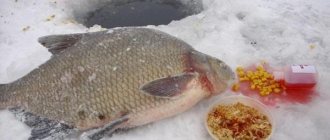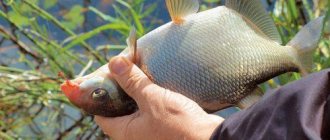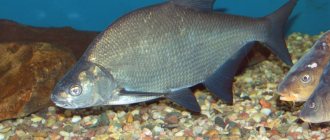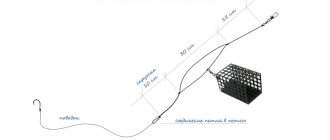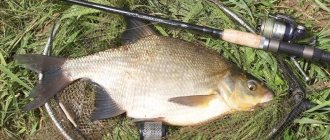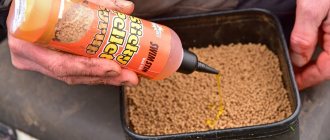Peculiarities of bream behavior in autumn
As the water temperature drops, the bream begins to move less around the reservoir and now the correctly chosen fishing point is even more important than in the summer. In the fall, bream begin to gather in schools and occupy pre-winter holes, while the fish no longer stray far from the parking area. Therefore, look for such parking points and try to make a bait table near them and then the chances of catching will increase.
You need to look for edges, slopes, slopes of channel holes and there try to bait the point from where fishing will be carried out. It is good if in such places on the bottom there is at least a small aquatic vegetation, where there may be various larvae that serve as food for bream. Such a point will be more promising.
Also in autumn, bream often moves far from the shore to depths and stays there, since the water temperature at such points is higher than on the surface.
Where to look for bream in September
To make your search easier, you need to have an idea about the lifestyle of bream. This predominantly bottom-dwelling fish practically does not change its annual places. At the beginning of the calendar autumn, in warm weather, the “bony” sticks to its summer routes and areas. As the weather gets colder, the habits, taste preferences and habitats of fish change.
The colder the water becomes, the deeper the bream descends. In large reservoirs, it chooses depths of 4-5 meters and deeper, coming out onto the shallows at night. Daily migrations are already insignificant and it is easier to keep the fish for a long time, with the help of baits and baits.
The best places to find bream at this time will be riverbed dumps and so-called “tables”. Tables are flat areas of the bottom where fish feed. The depth in these places is usually less than in the channel; the distance to the channel should be small.
Recommended reading: How to catch crucian carp in winter from ice
Bream does not like heavily cluttered places and snags, although a school may stand close to such areas.
An echo sounder will help a novice fisherman in searching for fish in a reservoir.
Feeder for autumn fishing
At this time, the bream is shy and behaves more cautiously than in the summer. Based on this, you need to properly prepare the tackle and equipment. And also pay close attention to the preparation of bait, which should interest the capricious bream.
Rod
Considering that you will need to look for a fishing point at a far distance from the shore, we take rods with a length of 3.9-4.2 meters, which allow long casts of up to 70 meters.
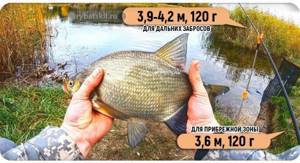
Ideally, to fish coastal areas, we take a rod 3.6 meters long. Feeder test up to 120 grams. With such a selection of rods, it is possible to fish the near, middle and far edge, which will significantly increase your chances of finding bream.
It is better to use a fiberglass whip (quivertip), as it is more sensitive and will show even the most accurate bite from a capricious fish.
Line and leash
Considering the fishing conditions and the behavior of the fish, it is better to use a braided line when fishing in the fall. This is mandatory when fishing for bream on a feeder at distances of more than 40 meters, but when fishing in coastal areas it is also better to use a cord, since it is more sensitive than monofilament and will better show uncertain bites of bream or bream.
Initially set the leash to a length of up to 50 centimeters and a diameter of 0.14 mm, if we are talking about early autumn. In October - November, a 0.10 mm leash is installed and used by the feeder when fishing on the river. A leash with a hook during this period is used more delicately.
Rigging and hooks
As an equipment, a working option would be the classic Paternoster. You can also use an asymmetrical loop, which is also capable of catching the smallest bites.
Place the feeder with a small feed capacity so as not to overfeed the fish with a large amount of food, but deliver food in small portions when casting. These should be open-type mesh feeders without a bottom so that the food is released faster and begins to work.

The hook is suitable with number 12 or 14 according to the European classification, and if we are talking about larger bream, then use number 10. Remember that the hook for the feeder is matched to the bait, and if it is a bloodworm, then we use No. 14 with thin wire, and if it is a worm or maggot, then No. 10 is better, especially when fishing on the river.
Features of bait production
In addition to the time of year, the composition of the bait is also affected by the weather. On hot days, bream is inactive and comes out to feed only in the morning and evening hours, and in cloudy and warm weather, bream actively feeds throughout the day. Therefore, experienced fishermen recommend adding sweet ingredients such as vanilla, honey, sugar to bait for hot weather, and bitter ingredients such as garlic or dill for cloudy weather.
The viscosity and consistency of bait are also affected by fishing conditions (current or standing water). When fishing occurs on the current, the bait should be more viscous, so clay or earth is added to the bait composition, which is thoroughly ground until it is full. It is better to take earth or clay near the reservoir where you are going to fish. When fishing in still water, the bait should be looser. If you are fishing from a boat at a depth of more than 5 m, the bait needs to be weighted; for this, clean river sand is added. When you have to fish in warm water, you don’t need to add live ingredients to the bait, even if it’s autumn or spring.
The qualitative composition of the bait depends on the food supply in the reservoir ; if you know that in a given reservoir bream ignores animal baits, then they should not be included in the bait. If the reservoir is poor in food supply, then it doesn’t really matter what you mix into the bait, the main thing is that it contains the components that bream feed on.
Bait for autumn bream
If you make a choice based on purchased bait for bream in the fall, then you should pay attention to the “cold water” marking, which should be on the package. Especially if we are talking about late autumn, when the water has already cooled down. This bait mixture has the following number of advantages:
- fine grind (dusty and light mixture);
- low calorie;
- many are spice-based;
- They have a dark color, which is less likely to repel fish.
When mixing autumn bait for bream, you can create a mix of several types of mixtures. Despite the fact that cold water bait is initially finely ground and does not contain large fractions, it would still be better to pass it through a 2-mm sieve.
Subsequently, if necessary, you can add a large fraction in the form of pastoncino, for example, which is more often used when fishing in the summer.
Cold water bait is very easy to over-wet, so add water in small portions when mixing.
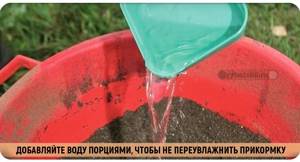
Usually 300–350 grams of water per 1 kilogram of bait mixture is sufficient. After mixing, leave the food to absorb moisture, and just before feeding, you can pass the bait through a 3-mm sieve to saturate the mixture with oxygen, which will help attract fish faster.
It is known that bream in the fall needs food containing protein, so you need to add animal components to the bait. This could be live or scalded maggots, food bloodworms, or red worms chopped into small pieces. It is the worm that can attract large individuals to the point. Fish oil, bone or fish meal are also added. Usually, it is enough to add 100 grams of animal component per kilogram of bait.
Required ingredients in bream bait
The composition of the food mixture to attract bream differs from bait for other aquatic inhabitants. Catching a trophy depends on the presence of the required ingredients and the size of the fractions. Bream, unlike many river species, is a large fish. A successful catch on the feeder in the area of reservoirs and large canals are individuals weighing up to 1 kg.
Reliable fishing for bream is impossible without high-quality bait. The check takes place directly while fishing. The main features of the bait are that the mixture must be heavy, inert, containing not only small components, but also large particles. Powdery components form a cloudy suspension, attractive to small bleak and roach, and large fractions stimulate the appetite of large fish. The desired consistency is created by the correct selection of additives to the base, which greatly enhance the attractiveness of the bait mixture.
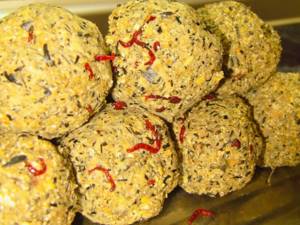
Ready-made feeding balls
The basis
Bulk components of plant origin are used as a feed base, which make up 60% of the total mass. The fish should be lured, but not saturated with fractions.
The basic components of bream bait are:
- cereal flakes;
- pearl barley and millet cereals;
- breadcrumbs;
- cookie;
- bran;
- semolina;
- sunflower cake.
The color of the mixture should be close to the shades of the soil. This approach helps to see the nozzle, individual bright particles against a dark background. Food coloring and mixing the bait mixture with clay and black soil help to achieve the desired tone.
The basis can be ready-made bait for bream, purchased in a store, but fishermen make the best mixture on their own.

Mixture with a shade of soil
Filler
The share of filler in the bait mass is close to 40% of the composition. Basically, the component includes:
- cereals processed in the process of boiling, steaming;
- animal ingredients, crushed or crushed.
The main purpose of the filler is its ability to retain fish in the feeding area for a long time. The calorie content of the filler is higher than the base, so excess content in the composition leads to overfeeding of bream and bream.
Popular components of mixtures are:
- peas;
- canned corn;
- pasta;
- steamed wheat grain;
- crushed rapeseed, pumpkin, flax seeds;
- all kinds of cereals, mixed feed.
When preparing porridge, it should be taken into account that, unlike crucian carp, bream are not attracted to the mucous surface. Boiled grains should be well washed, without stickiness. Large fractions include pearl barley particles, boiled peas, and corn. Bean components should not be pureed. It is necessary to maintain the shape of the grains, then the bait will become a real delicacy.
The animal component is represented by chopped dung worms, bloodworms, live or scalded maggots, amphipods, and lard.

Mixture with maggot and bloodworms
It is important to consider that the filler in the bait should be the same as the fish bait (bloodworm, corn, etc.).
Binding Ingredients
Bream fishing takes place on a river current, so the bait mixture should not quickly become wet during the immersion process. A stable combination of ingredients occurs when the binder elements are included in the composition in a volume of 3-5% of the composition. The bait will be effective if it reaches the bottom and begins to gradually disintegrate into separate fractions.
The binding ingredients are:
- chopped oatmeal;
- clay;
- semolina;
- flour;
- bran;
- soil from the bottom of the reservoir;
- pea mash.
According to the general rule, the consistency of complementary foods is such that from a separate piece of the prepared mass it is easy to form a dense ball about the size of an apple. There should also not be excessive viscosity, so that after touching the bottom the mixture breaks into pieces.
During the preparation process, it is enough to use at least one component, moisten the composition with water to form balls.
Flavors
The bream's sense of smell is very developed. Fish in complete darkness are able to find food by sensing odors. The aroma of flaxseed is especially attractive to bream. To enhance the smell, the seeds are roasted and then ground in a coffee grinder.
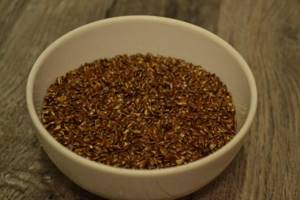
Roasted flax seeds
A suitable bait can increase the catch rate, but mistakes in the selection of scents can cost the fish completely away from the feeding area. Special attractants, synthetic or natural, can be easily purchased at a fishing store. Based on the specific smell, flavorings are conventionally divided into groups:
- fruit and berry;
- spicy;
- meat;
- fish;
- spices, etc.
In sun-warmed water, above 10° C, the sweetish smells of berries, fruits, as well as the aromas of caramel and chocolate are suitable for hunting bream. Additives include crushed pear, banana, strawberry or corresponding extracts, fruit essences. Among artificial additives, the exotic composition tutti-frutti is popular.
In a cold body of water, less than 10° C, fish are attracted to the aromas of coriander, cinnamon, and meat and fish flavors.
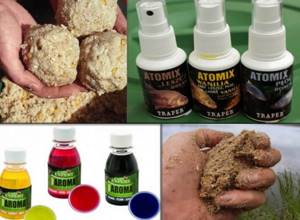
Flavors from a fishing store
Among well-known products you can also find natural ingredients with persistent odors that can be easily incorporated into feed. To attract the trophy to the fishing zone, coffee, cocoa, cinnamon, and vanilla sugar are used. Use crushed herbs, seeds - anise, mint, lemon balm, dill. Fishermen often individually select the required component for hot conditions and night fishing. Dunaev baits.
How to use aromatics
In cold water, you need to use various types of aromatics extremely carefully so as not to overdo it and not scare away the fish. However, you shouldn’t give it up completely either.
You can add a little molasses containing betaine, to which bream responds well. Molasses improves the digestion of fish, which stimulates its appetite. Molasses is added to the water when mixing bait. In late autumn, it is enough to add about 100 ml of molasses per 500 ml of water.
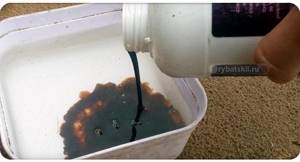
As for the aroma, in the form of a liquid, for example, it can be added directly to the bait before mixing. That is, add it to the dry mixture and mix. Thus, not all of the bait will be saturated with aromatics, but only some of its particles, and they will be saturated unevenly, which works well in the fall.
What to use to catch bream in the fall on a feeder
When choosing a bait for bream in the fall, first of all you need a large bloodworm, without which fishing in the late period is unlikely to be successful. Maggots are often placed on the hook of bloodworms, but worms are usually added to the bait. However, you can use the worm as bait as an experiment.
Further, while fishing on the feeder in the fall, be guided by which bait is best to use depending on how the bream reacts to it. If the fish eats the bloodworm, but the maggot remains untouched, then we remove it from the hook and try to catch only with bloodworms. Here you can also experiment and put different numbers of moths on the hook.
Fishing tactics on the river in autumn
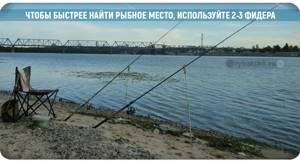
Usually feeders prefer to fish with one feeder rod, but in the fall it is better to base their fishing tactics on fishing with several feeders. The location of bream in autumn is unpredictable, and in order to quickly find a fishing spot, it is better to use 2-3 rods. The fish may stand several meters before the edge, or after it, and searching with one fishing rod will be more difficult.
We recommend starting your search for a point at close range, as it is easier and faster. As a rule, this is a point at a distance of 25–30 meters from the shore. Next, we look for a point at an average distance of about 50 meters, and at a far distance up to 70–80 meters. After finding the points, we do the clipping and start feeding.
For the initial feeding, it will be enough to make 5 casts each, and then make recasts at intervals of about 2 minutes. Make starter feeding without adding live ingredients to the bait, so as not to quickly saturate the fish. Later, during the fishing process, you can add bloodworms and chopped worms to the food.
Start fishing at a close distance, and if no bites are observed within 30 minutes, then do not linger and move to the next distance of 50 meters. Always increase the distance if there are no bites.
Fishing depending on month
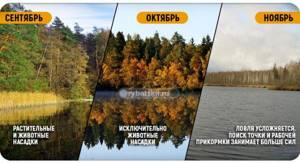
Fishing for bream in the fall can be different and a lot depends on the region and weather conditions in this region in a particular month. Somewhere in September there may still be warm, almost summer weather and then fishing will be easier, but in late autumn it will be real hard fishing with a lot of experiments.
September
In September, if the weather stays closer to summer, then the fishing strategy is not much different. You can feed more, and when fishing, try to use not only baits of animal origin, but also plant baits, such as corn, for example.
Read more about the nuances of catching bream in September on a feeder.
October
In October, as the weather gets colder, the preferences of bream are already beginning to shift in favor of protein, and here you can no longer take vegetable baits with you. Finding bream in October is already more difficult, and where it was in September it may no longer be there. We need to be more active in searching for fish.
In October, it is already harder to catch a trophy during the day, and fishermen effectively make night trips, when there is a greater chance of catching a large bream during this period.
November

In November, real hard fishing begins, when maximum attention is paid to finding a fishing spot, as well as preparing bait and selecting bait. Try combining different mixes of bait, and also pay attention to adding an animal component to the food, while doing it in small portions.
In late autumn, catching bream is more difficult and more experience is required, and sometimes experience does not help. However, this is possible, and the main thing here is not to give up, but to try a wide variety of options, from changing equipment elements to combining nozzles. And then your chances of success will increase significantly.
Rating of the best baits for catching bream
| Nomination | place | Name of product | price |
| Rating of the best baits for catching bream | 1 | Sensas 3000 Club Bremes | 380 ₽ |
| 2 | Marcel Van Den Eynde Kastaar | 315 ₽ | |
| 3 | Traper Gold Series Champion | 310 ₽ | |
| 4 | Dunaev Premium Bream | 140 ₽ | |
| 5 | GF Feeder Bream | 120 ₽ | |
| 6 | Hook Balls Bream | 120 ₽ | |
| 7 | Greenfishing GF Bream Sweet Brown | 140 ₽ |
Sensas 3000 Club Bremes
Rating: 4.9

The French bait Sensas 3000 Club Bremes attracts bream at any time. Both amateur fishermen and experts have seen its effectiveness in practice. The strengths of the mixture are its high stickiness, which allows the bait ball or feeder to be delivered to the very bottom without loss. Gradually disintegrating in the bottom layer, the composition attracts fish to the fishing point and retains it for a long time. At the same time, the bream does not become saturated, thanks to the competent selection of components. The subtle aroma of flavoring additives helps attract trophy fish. Groundbait can be used with equal success both in float fishing and in feeder fishing.
Domestic fishermen speak flatteringly about the attractiveness of French bait for bream at any time of the year. The only downside is the high price.
Advantages
- versatility;
- successful selection of ingredients;
- holds fish for a long time;
- attract large bream.
Flaws
- high price.
Marcel Van Den Eynde Kastaar
Rating: 4.8
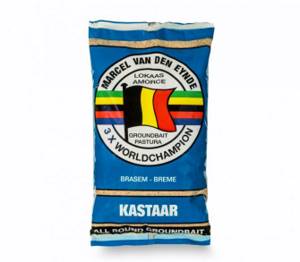
The Belgian bait Marcel Van Den Eynde Kastaar demonstrates excellent results in the summer. It has a magical effect on both bream and carp. Experts in the field of fishing sports took an active part in developing the composition. Since the composition is not designed for low temperatures, the scope of application is limited to the warm season. The peculiarity of the bait is its lightness. Therefore, without adding weights, it can be used in still water or on rivers with a slow current and shallow depth. As for the fishing method, feeders are most often interested in the composition.
Anglers liked the ease of mixing and its attractiveness to bream and bream. Bait helps out in moments of lack of bite. The disadvantage of the composition is seasonality.
Advantages
- reasonable price;
- successful selection of ingredients;
- simple preparation;
- attractive to bream.
Flaws
- not suitable for cold water.
Traper Gold Series Champion
Rating: 4.7
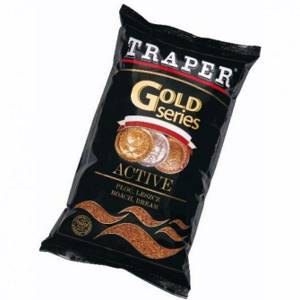
For maximum fishing results, the famous Polish manufacturer Traper has created a series of Gold baits. To catch bream in waters with a current, the Champion composition is best suited. It is a mixture of fine river sand and edible ingredients. Experts recommend adding specialized bait for a specific type of fish. There are two color options to choose from (light brown and red). Experienced fishermen consider the red composition to be more universal; it is used from spring to late autumn. In summer, light brown groundbait has proven itself well. The composition becomes the bronze medalist of our review.
Russian fishermen are satisfied with the effectiveness of bait on the current, its versatility, and high-quality grinding. The only disadvantage is the high price.
Advantages
- two colors;
- versatility;
- high quality;
- good viscosity.
Flaws
- high price.
Dunaev Premium Bream
Rating: 4.7
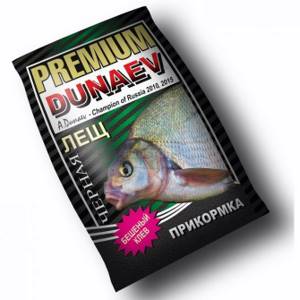
One of the most popular baits on the Russian market is Dunaev Premium Bream. Domestic development can be seen in the hands of beginners and professional athletes. Participants in fishing competitions took an active part in the selection of ingredients, as well as during testing. The composition is quite complex; the recipe contains 18 unique components. Their combination allows you to lure bream using different gear. This could be a popular feeder or a traditional float. Experts note that some components are manufactured in the manufacturer’s own workshops, which increases the shelf life of the bait.
In RuNet, the composition received many flattering reviews for its affordable price, pleasant smell, and ease of mixing. But in a strong current, the bait is quickly washed out of the feeder.
Advantages
- fresh ingredients;
- affordable price;
- nice smell;
- ease of mixing.
Flaws
- quickly washed away by the current.
GF Feeder Bream
Rating: 4.6
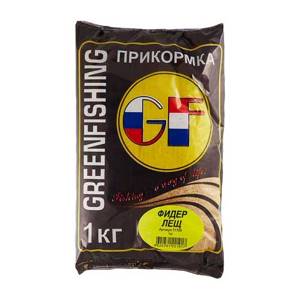
Many Russian fishermen, when fishing for bream, prefer the GF Feeder Bream bait. It works effectively in warm water, activating the fish's appetite. The basis of the bait is protein, biscuit and shortbread. This combination makes the mixture attractive, but not filling. Experts note the uniform distribution of bait on the bottom surface, as a result of which a school of bream lingers for a long time at the fishing point. To achieve maximum effect, the manufacturer has enriched the composition with imported flavors and additives. The bait mixture was awarded a silver medal at the “Hunting and Fishing in Rus'” exhibition.
Domestic fishermen praise the bait for its low price, variety of colors, and uniformity of the fraction. Among the disadvantages, there is a deterioration in attractiveness in cold water.
Advantages
- low price;
- large selection of colors;
- homogeneous fraction;
- does not saturate the fish.
Flaws
- seasonal use.
Hook Balls Bream
Rating: 4.5
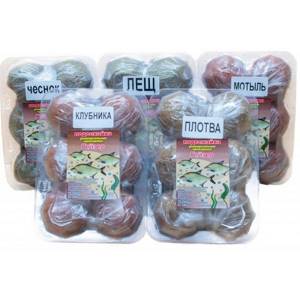
The ideal option for float fishing for bream in winter and summer would be the Bream Podsekayka balls. The manufacturer has prepared optimal portions of bait; 6 balls with a total weight of 0.8 kg are placed in a plastic package. Experts recommend Podsekayaka to beginner fishermen. The balls do not need to be soaked or compacted. Immediately from the package they are thrown to the fishing point. To prepare the mixture, the manufacturer used only natural ingredients. When developing the composition, the developments of experienced bream workers were taken into account. The balls have proven themselves best on stagnant bodies of water or on slow rivers. The product closes the TOP 6 of our review.
Fishermen are satisfied with the ease of use; they do not need to carry mixers, buckets and sieves with them. And beginners will not make mistakes when kneading.
Advantages
- ease of use;
- affordable price;
- natural ingredients;
- attractive to bream.
Flaws
- It is not possible to add additional ingredients.
Greenfishing GF Bream Sweet Brown
Rating: 4.5

The basis of Greenfishing GF Bream Sweet Brown bait is biscuit and shortbread. But experts consider steamed crushed corn to be the main secret of the composition. The smell of sunflower and hemp cake, roasted hemp and flax will be attractive to bream. The mixture is enriched with vitamins and amino acids, a unique protein supplement based on gammarus and dried bloodworms. The manufacturer has made a homogeneous consistency with a particle size of 100-200 microns. Russian developers used French flavors. The angler can choose from four colors (red, red, green and dark brown).
So far there are few reviews about bait on fishing forums. It looks like the fish haven't had time to taste it yet.
Advantages
- small homogeneous fraction;
- large set of components;
- choice of colors;
- affordable price.
Flaws
- few reviews.
